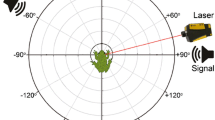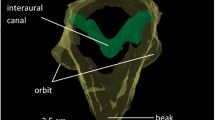Summary
The physical measurements reported here test whether the European starling (Sturnus vulgaris) evaluates the azimuth direction of a sound source with a peripheral auditory system composed of two acoustically coupled pressure-difference receivers (1) or of two decoupled pressure receivers (2).
A directional pattern of sound intensity in the freefield was measured at the entrance of the auditory meatus using a probe microphone, and at the tympanum using laser vibrometry. The maximum differences in the soundpressure level measured with the microphone between various speaker positions and the frontal speaker position were 2.4 dB at 1 and 2 kHz, 7.3 dB at 4 kHz, 9.2 dB at 6 kHz, and 10.9 dB at 8 kHz. The directional amplitude pattern measured by laser vibrometry did not differ from that measured with the microphone. Neither did the directional pattern of travel times to the ear. Measurements of the amplitude and phase transfer function of the starling's interaural pathway using a closed sound system were in accord with the results of the free-field measurements.
In conclusion, although some sound transmission via the interaural canal occurred, the present experiments support the hypothesis 2 above that the starling's peripheral auditory system is best described as consisting of two functionally decoupled pressure receivers.
Similar content being viewed by others
Abbreviations
- CM :
-
cochlear microphonics
- ITD :
-
interaural time difference
- IID :
-
interaural intensity difference
- MRA :
-
minimum resolvable angle
- dB SPL :
-
sound-pressure level (re 0.00002 Pa)
References
Anderson DJ, Rose JE,Hind JE, Brugge JF (1971) Temporal position of discharges in single auditory nerve fibres within the cycle of a sine-wave stimulus: frequency and intensity effects. J Acoust Soc Am 49:1131–1139
Bendat JS, Piersol AG (1980) Engineering applications of correlation and spectral analysis. Wiley, New York
Calford MB, Piddington RW (1988) Avian interaural canal enhances interaural delay. J Comp Physiol A 162:503–510
Coles RB, Guppy A (1988) Directional hearing in the barn owl (Tyto alba). J Comp Physiol A 163:117–133
Coles RB, Lewis DB, Hill KG, Hutchings ME, Gower DM (1980) Directional hearing in the Japanese quail (Coturnix coturnix japonica) II. Cochlear physiology. J Exp Biol 86:153–170
Counter SA, Borg E (1982) The avian stapedius muscle. Acta Otolaryngol 94:267–274
Gleich O, Narins PM (1988) The phase response of primary auditory afferents in a songbird (Sturnus vulgaris L.). Hear Res 32:81–92
Granit O (1941) Beiträge zur Kenntnis des Gehörsinns der Vögel. Omis fennica 18:49–71
Hill KG, Lewis DB, Hutchings ME, Coles RB (1980) Directional hearing in the Japanese quail (Coturnix coturnix japonica). I. Acoustic properties of the auditory system. J Exp Biol 86:135–151
Klump GM, Windt W, Curio E (1986) The great tit's (Parus major) auditory resolution in azimuth. J Comp Physiol A 158:383–390
Kuhn GF (1977) Model for interaural time differences in the horizontal plane. J Acoust Soc Am 62:157–167
Lewald J (1987a) The acuity of sound localization in the pigeon (Columba livia). Naturwissenschaften 74:296–297
Lewald J (1987b) Interaural time and intensity difference thresholds of the pigeon (Columba livia). Naturwissenschaften 74:449–451
Lewald J (1989) Verhaltensphysiologische und neurophysiologische Untersuchungen zum Richtungshören der Taube. Dissertation, Ruhr-Universität Bochum
Lewald J (1990a) The directionality of the ear of the pigeon (Columba livia). J Comp Physiol A 167:533–543
Lewald J (1990b) Neural mechanism of directional hearing in the pigeon. Exp Brain Res 82:423–436
Michelsen A, Larsen ON (1978) Biophysics of the ensiferan ear. I. Tympanal vibrations in bushcrickets (Tettigoniidae) studied with laser vibrometry. J Comp Physiol 123:193–203
Moiseff A (1989a) Binaural disparity cues available to the barn owl for sound localization. J Comp Physiol A 164:629–636
Moiseff A (1989b) Bi-coordinate sound localization by the barn owl. J Comp Physiol A 164:637–644
Moiseff A, Konishi M (1981) The owl's interaural pathway is not involved in sound localization. J Comp Physiol 144:299–304
Oeckinghaus H, Schwartzkopff J (1983) Electrical and acoustical activation of the middle ear muscle in a songbird. J Comp Physiol 150:61–67
Park TJ (1989) Sound localization in small birds. Dissertation, University of Maryland
Park TJ, Dooling RJ (1991) Sound localization in small birds: Absolute localization in azimuth. J Comp Psychol 105:125–133
Rayleigh Lord (1907) On our perception of sound direction. Philos Mag 13:214–232
Rosowski JJ (1979) The interaural pathway of the pigeon and sound localization: Does the pigeon ear act as a differential pressure transducer? Dissertation, University of Pennsylvania
Rosowski JJ, Saunders JC (1980) Sound transmission through the avian interaural pathways. J Comp Physiol 136:183–190
Roth GL, Kochhar RK, Hind JE (1980) Interaural time differences: Implications regarding the neurophysiology of sound localization. J Acoust Soc Am 68:1643–1651
Sachs MB, Woolf NK, Sinnott JM (1980) Response properties of neurons in the avian auditory system: Comparisons with mammalian homologues and consideration of neural encoding of complex stimuli. In: Popper AN, Fay RR (eds) Comparative studies of hearing in vertebrates. Springer Berlin Heidelberg New York, pp 323–353
Saunders JC (1985) Auditory structure and function in the bird middle ear: An evaluation by SEM and capacitive probe. Hear Res 18:253–268
Schwartzkopff J (1950) Beitrag zum Problem des Richtungshörens bei Vögeln. Z Vergl Physiol 32:319–327
Schwartzkopff J (1952) Untersuchungen über die Arbeitsweise des Mittelohres und das Richtungshören der Singvögel unter Verwendung von Cochlea-Potentialen. Z Vergl Physiol 34:46–68
Stevens SS, Newman EB (1936) The localization of actual sources of sound. Am J Psychol 48:297–306
Volman SF, Konishi M (1990) Comparative physiology of sound localization in four species of owls. Brain Behav Evol 36:196–215
Author information
Authors and Affiliations
Rights and permissions
About this article
Cite this article
Klump, G.M., Larsen, O.N. Azimuthal sound localization in the European starling (Sturnus vulgaris). J Comp Physiol A 170, 243–251 (1992). https://doi.org/10.1007/BF00196906
Accepted:
Issue Date:
DOI: https://doi.org/10.1007/BF00196906




